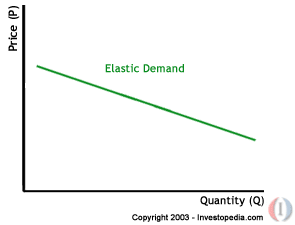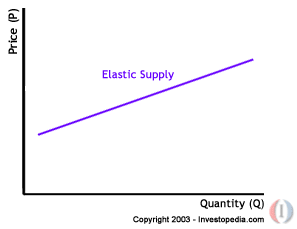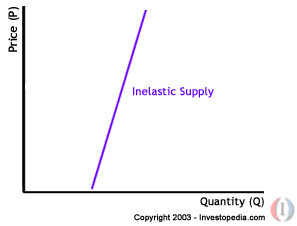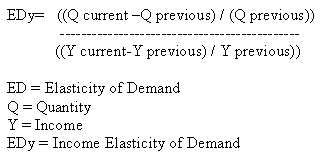The degree to which a demand or supply curve reacts to a change in price is the curve's elasticity. Elasticity varies among products because some products may be more essential to the consumer. Products that are necessities are more insensitive to price changes because consumers would continue buying these products despite price increases. Conversely, a price increase of a good or service that is considered less of a necessity will deter more consumers because the opportunity cost of buying the product will become too high.
A good or service is considered to be highly elastic if a slight change in price leads to a sharp change in the quantity demanded or supplied. Usually these kinds of products are readily available in the market and a person may not necessarily need them in his or her daily life. On the other hand, an inelastic good or service is one in which changes in price witness only modest changes in the quantity demanded or supplied, if any at all. These goods tend to be things that are more of a necessity to the consumer in his or her daily life.
To determine the elasticity of the supply or demand curves, we can use this simple equation:
| Elasticity = (% change in quantity / % change in price) |
If elasticity is greater than or equal to one, the curve is considered to be elastic. If it is less than one, the curve is said to be inelastic.
As we mentioned previously, the demand curve is a negative slope, and if there is a large decrease in the quantity demanded with a small increase in price, the demand curve looks flatter, or more horizontal. This flatter curve means that the good or service in question is elastic.
 |
Meanwhile, inelastic demand is represented with a much more upright curve as quantity changes little with a large movement in price.
 |
Elasticity of supply works similarly. If a change in price results in a big change in the amount supplied, the supply curve appears flatter and is considered elastic. Elasticity in this case would be greater than or equal to one.
 |
On the other hand, if a big change in price only results in a minor change in the quantity supplied, the supply curve is steeper and its elasticity would be less than one.
 |
A. Factors Affecting Demand Elasticity
There are three main factors that influence a demand's price elasticity:
1. The availability of substitutes - This is probably the most important factor influencing the elasticity of a good or service. In general, the more substitutes, the more elastic the demand will be. For example, if the price of a cup of coffee went up by $0.25, consumers could replace their morning caffeine with a cup of tea. This means that coffee is an elastic good because a raise in price will cause a large decrease in demand as consumers start buying more tea instead of coffee.However, if the price of caffeine were to go up as a whole, we would probably see little change in the consumption of coffee or tea because there are few substitutes for caffeine. Most people are not willing to give up their morning cup of caffeine no matter what the price. We would say, therefore, that caffeine is an inelastic product because of its lack of substitutes. Thus, while a product within an industry is elastic due to the availability of substitutes, the industry itself tends to be inelastic. Usually, unique goods such as diamonds are inelastic because they have few if any substitutes.2. Amount of income available to spend on the good - This factor affecting demand elasticity refers to the total a person can spend on a particular good or service. Thus, if the price of a can of Coke goes up from $0.50 to $1 and income stays the same, the income that is available to spend on coke, which is $2, is now enough for only two rather than four cans of Coke. In other words, the consumer is forced to reduce his or her demand of Coke. Thus if there is an increase in price and no change in the amount of income available to spend on the good, there will be an elastic reaction in demand; demand will be sensitive to a change in price if there is no change in income.3. Time - The third influential factor is time. If the price of cigarettes goes up $2 per pack, a smoker with very few available substitutes will most likely continue buying his or her daily cigarettes. This means that tobacco is inelastic because the change in price will not have a significant influence on the quantity demanded. However, if that smoker finds that he or she cannot afford to spend the extra $2 per day and begins to kick the habit over a period of time, the price elasticity of cigarettes for that consumer becomes elastic in the long run.
B. Income Elasticity of Demand
In the second factor outlined above, we saw that if price increases while income stays the same, demand will decrease. It follows, then, that if there is an increase in income, demand tends to increase as well. The degree to which an increase in income will cause an increase in demand is called income elasticity of demand, which can be expressed in the following equation:
 |
If EDy is greater than one, demand for the item is considered to have a high income elasticity. If however EDy is less than one, demand is considered to be income inelastic. Luxury items usually have higher income elasticity because when people have a higher income, they don't have to forfeit as much to buy these luxury items. Let's look at an example of a luxury good: air travel.
Bob has just received a $10,000 increase in his salary, giving him a total of $80,000 per annum. With this higher purchasing power, he decides that he can now afford air travel twice a year instead of his previous once a year. With the following equation we can calculate income demand elasticity:
 |
Income elasticity of demand for Bob's air travel is seven - highly elastic.
With some goods and services, we may actually notice a decrease in demand as income increases. These are considered goods and services of inferior quality that will be dropped by a consumer who receives a salary increase. An example may be the increase in the demand of DVDs as opposed to video cassettes, which are generally considered to be of lower quality. Products for which the demand decreases as income increases have an income elasticity of less than zero. Products that witness no change in demand despite a change in income usually have an income elasticity of zero - these goods and services are considered necessities.
No comments:
Post a Comment